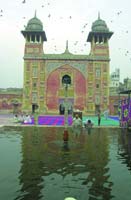|
Awaiting
repair
|
|
By Amna Nasir
|
 |
In
the heart of Lahore's old city, near Delhi gate,
stands Wazir Khan Mosque, surrounded by congested
narrow streets, old buildings, shops, and the
day-to-day hustle and bustle that is so typical
of this area.
The mosque was
built in 1044 A.H (1634 A.D), by Hakim Ilmuddin
Ansari, during Shah Jahan's reign. Historical
records show that he was a physician who cured
foot ailment one of Jahangir's wives was suffering
from. Later, Shah Jahan made him his viceroy in
Punjab and awarded him with the title of Wazir
Khan. Once in a position of power, he went on
to build several mosques, bazaars and palaces,
particularly inside Tibbi Bazaar and Taxali Gate.
|
The Wazir Khan Mosque
is considered to be a magnificent example of Mughal
architecture, and is covered entirely with arabesque
paintings and lacquered tiles. The colourful exterior
and interior has been done up with mosaics and frescoes,
geometric forms, floral designs, calligraphy and Quranic
text. A strong Persian influence can be seen in its
design and decoration as Persian artists supervised
the local craftsmen.
One can see exquisite impressions depicting
trees, flowers (such as daisies, lilies and sunflowers),
clouds, grapevine, fruits and vases. Archaeologists
and the common art lovers to the mosque can't help but
be enchanted by the beauty of the architecture. The
work is strictly inlay, not painted decoration. The
richness of the designs, arabesque frescoes and superb
calligraphy, having freshness in variety and colours,
have had many admirers and makes this mosque a place
worth visiting.
During a recent visited, the first sight
of the mosque gave a rude shock. At the main gateway,
goats were fastened and there was considerable muck
that emitted a strong stink, to make one turn back even
before entering the mosque's premises. Some children
could be seen scratching the frescoes with sharp tools.
Rooms and corridors, with their vestibules,
arches and doorways, were in a state of decay due to
bad treatment. Some rooms had been rented out by the
Auqaf, as one of the tenants told me. A room beside
the prayer chamber was used as a store room, and it
had frescoes that must have been beautiful once. But,
alas, the walls were damaged and inlay work had been
scrapped off at places, with many broken pieces of tiles
lying in a corner. Cracks were visible on many parts
of the floor.
Another part of the mosque that had
lost its original grandeur was the exterior of south
and north sides of prayer chamber, facing the bazaar.
It clearly depicted the callous and indifferent attitude
of the authorities towards the maintenance and restoration
of the place. A couple of years back, the director of
Auqaf said that work for preservation and rehabilitation
would start soon, unfortunately no concrete measures
have been taken as yet. Even, last year chief secretary
Punjab, Hafiz Akhtar Randhawa received check of 348,000
rupees from American Ambassador Nancy J. Powel for restoration
of this mosque.
Recently, there came a promising news
that the provincial minister for religious affairs and
Auqaf had resolved to get repair and rehabilitation
work on the mosque under way. But, according to a Punjab
Archaeology Department official, no measures seem to
be forth coming.
A photographer once said that Marilyn
Monroe was ideally photographed in the afternoon light,
while Marlene Dietrich looked her best by candlelight.
The same holds true for buildings. Taj Mahal gains its
romantic appeal from the moonlight. As for Wazir Khan's
Mosque, it should be seen in the setting sun, when tiles
seem to glow and an exotic tinge is added to its surroundings.
One hopes that whatever is left of the
original craftsmanship and grandeur of Wazir Khan Mosque
will be preserved for the future generations before
it is too late.
|
